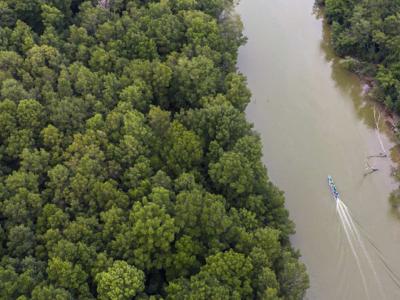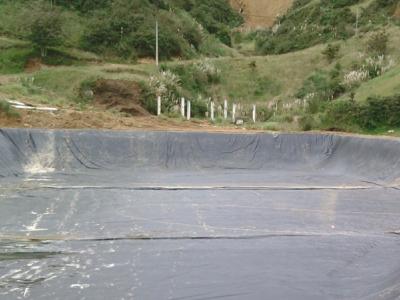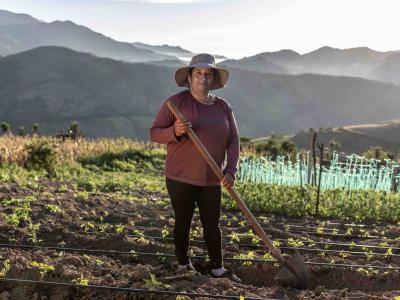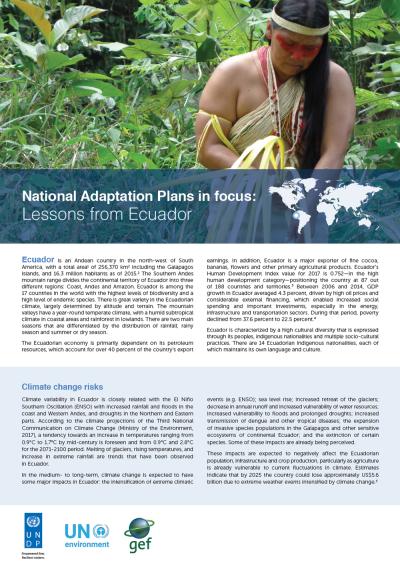Ecuador faces a variety of climate change risks associated with changes in temperature and precipitation, as well as possible alterations to ocean currents. Given its geographical location and rugged topography, Ecuador is a highly vulnerable country to impacts of climate change (UNFCCC First National Communication, Quito, 2000). Periodic El Niño events, particularly those of 1982-83 and 1997-98, have demonstrated the catastrophic effects of climate variability in the country. This high degree of exposure, combined with the vulnerability of key economic sectors such as agriculture, health, energy, water resources, coastal resources, fisheries, infrastructure and tourism, reinforces the notion that Ecuador is a country particularly vulnerable to climate change.
Characterized by extreme diversity of climate zones, Ecuador boasts an extraordinary array of geographical systems that range from high altitude glaciers to tropical rain forests in the Amazon upper tributaries to dry tropical forest on the Pacific Coast, as well as an insular outpost in the Pacific with the Galapagos Islands, a World Heritage Site. Some of these systems show a greater sensitivity to climate change, or at least are considered most likely to undergo rapid changes as a result of climate change, including variability. As highlighted in the Millennium Ecosystem Assessment Summary Report, such ecosystems provide a range of environmental services that are critical to rural livelihoods and urban welfare. As these systems deteriorate due to various direct and indirect factors, including climate change, the quality of environmental goods and services also decreases.
There is a UNDP-GEF project working to mainstream climate change adaptation into water management practices in Ecuador through the integration of climate change risks in key national and local development plans, the implementation of adaptation measures, information management, and knowledge sharing. At the national level, the project will improve water governance by incorporating climate risks and vulnerability assessments into water management and decision making processes. At the local level, interventions will take place in specific provinces (Los Rios, Manabi, Loja, and Azuay) that have been identified based on climate change vulnerability assessments and stakeholder consultations.
Source: GEF Project Details: Ecuador - Enabling Ecuador to Prepare its First National Communication in Response to its Commitments to UNFCCC. Accessed online at: http://gefonline.org/projectDetailsSQL.cfm?projID=629 on 12 November 2009.
Like most countries in Latin America, Ecuador has submitted one national communication to the United Nations Framework Convention on Climate Change (UNFCCC) with a second one under preparation. The Second National Communication is under preparation and scheduled to be completed by March 2010. One of the components of this Communication will be the National Climate Change Adaptation Strategy, as well as a revised GHG national inventory. A National Climate Change Adaptation Strategy has been proposed by the Ministry of Environment and will be included in the Second National Communication.
Land use change and forestry are the largest contributors to GHG emissions in the country. The emission reduction potential of the agricultural sector (including land use change and forestry) is significant and not yet sufficiently explored in the country. Agriculture is highly vulnerable to weather variability. Sustainable water management and climate-sensitive insurance coverage for agricultural production can reduce some of the observed vulnerabilities in the country.
Source: World Bank Country Notes on Climate Change Aspects in Agriculture. Accessed on: 24 May 2010 at http://web.worldbank.org/WBSITE/EXTERNAL/COUNTRIES/LACEXT/0,,contentMDK:22077094~pagePK:146736~piPK:146830~theSitePK:258554,00.html
For additional information refer to the World Bank Country Notes.
The Country Notes are a useful tool for organizing in a systematic way the available information on climate change and agriculture in each country. They provide a brief summary of information pertinent to both climate change and agriculture in 19 countries in LAC, with focus on policy developments (action plans and programs), institutional make-up, specific adaptation and mitigation strategies, as well as social aspects and insurance mechanisms to address risk in the sector.
Active Projects
Projects Completed
Latest Updates
See allLatest Publications
See allThis NAP in focus country briefing on the process to formulate and implement National Adaptation Plans in Ecuador considers firstly the country…








